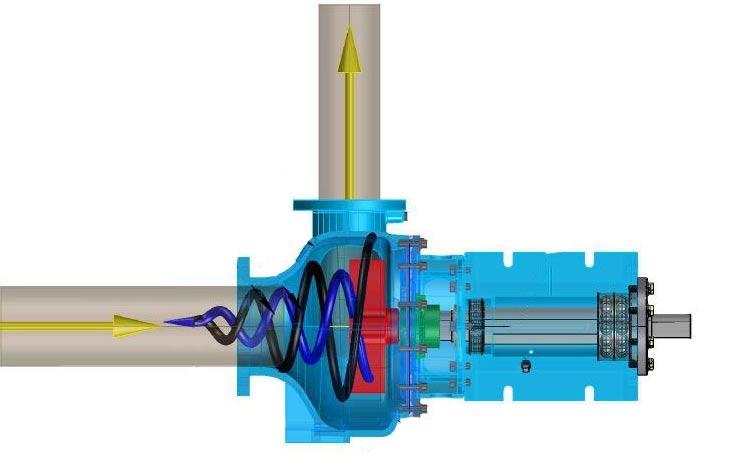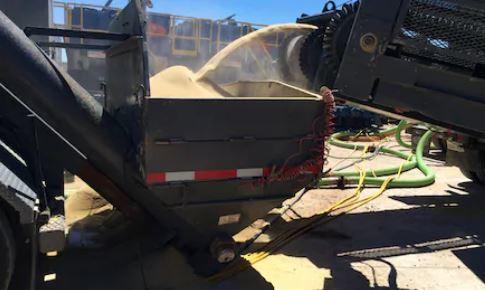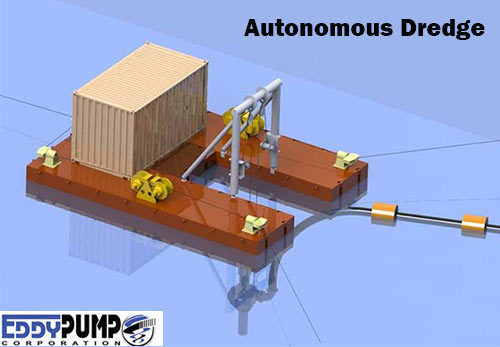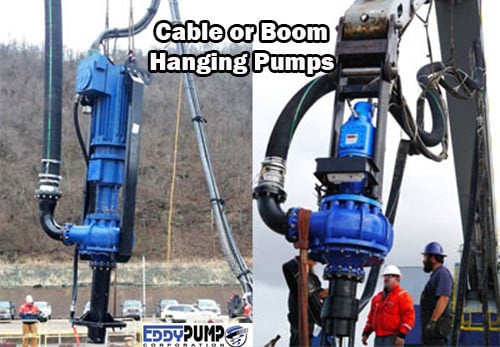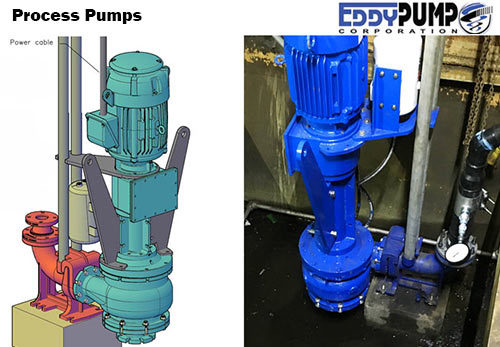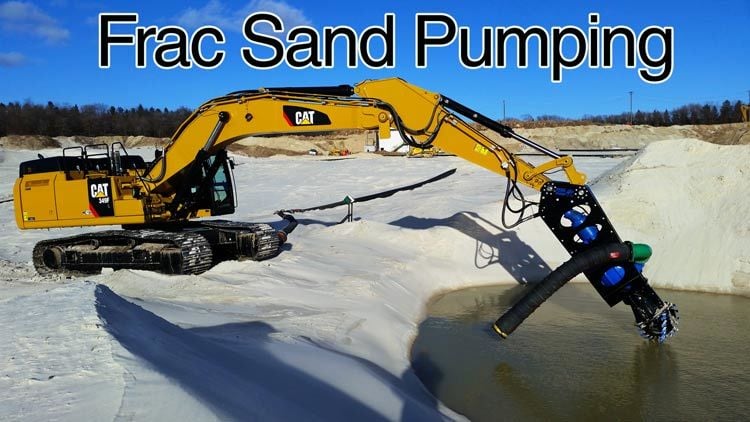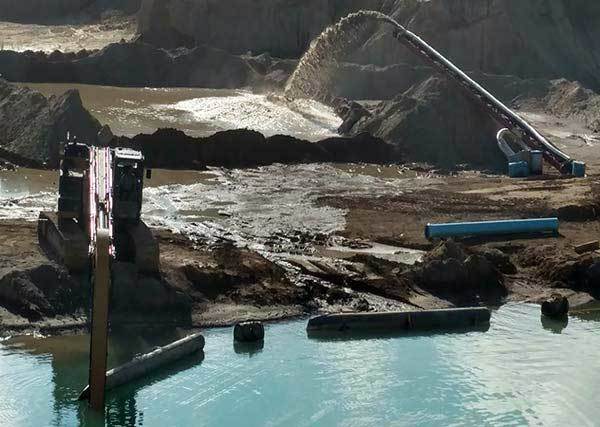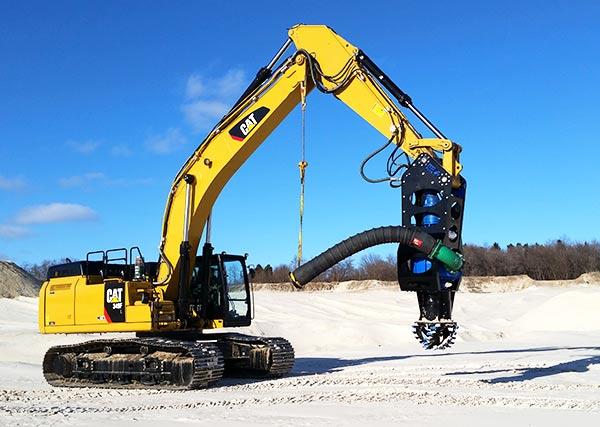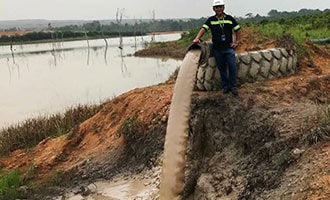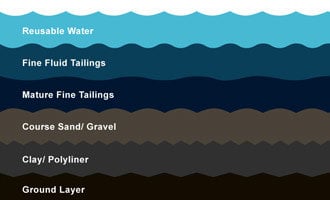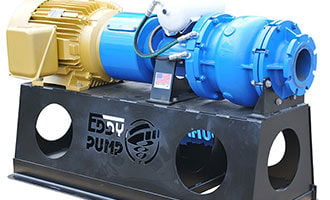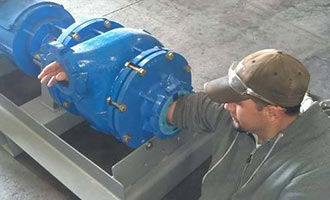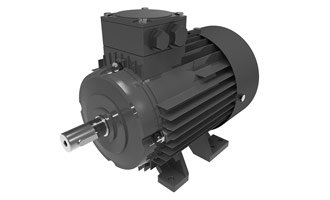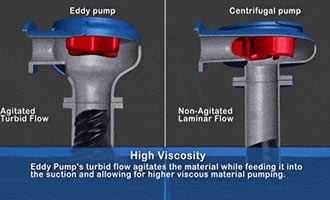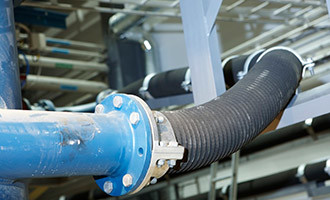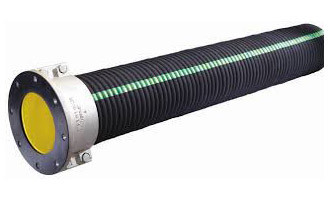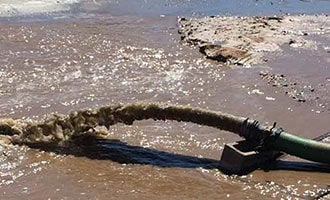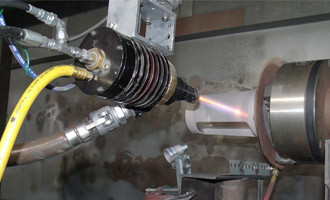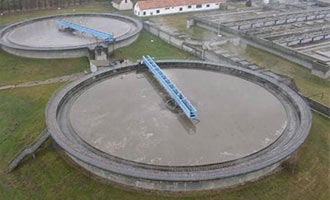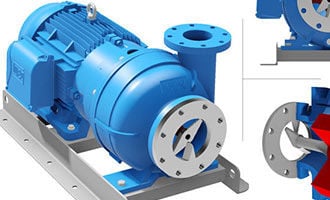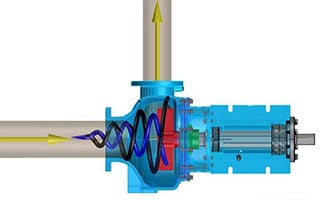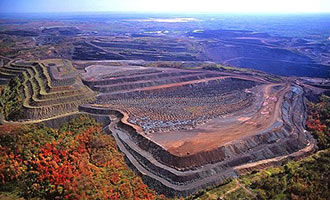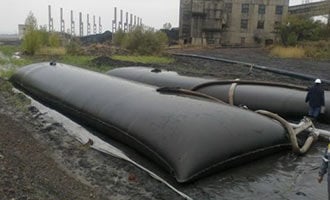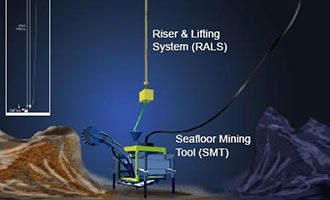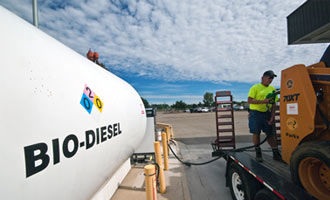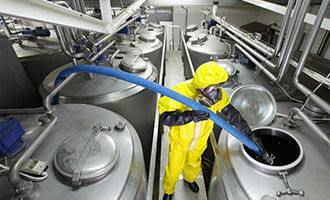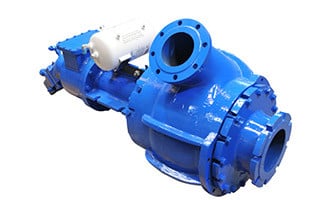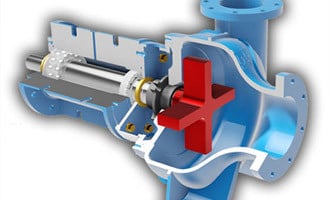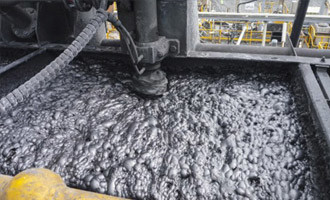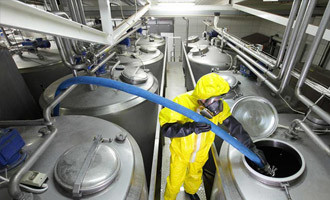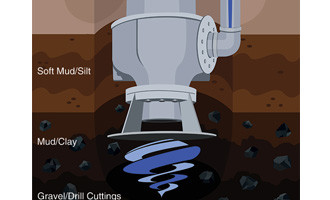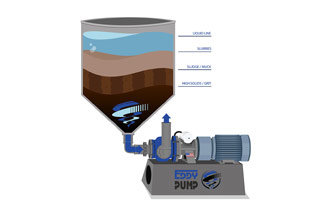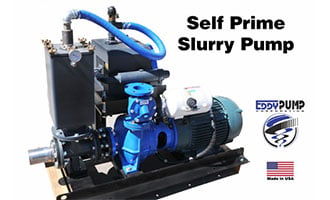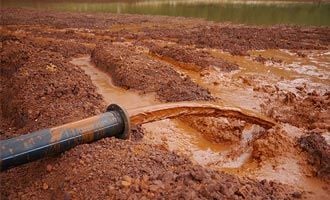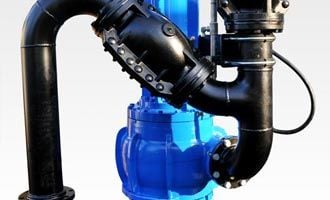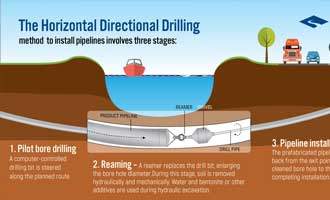Frac Sand Pump Applications
Frac Sand Pump Applications:
- Mining the Frac Sand
- Frac Blending Rigs
- Discharging the Frac Sand
- Frac Sand Pumping Equipment
Frac Sand Mining
High production costs, coupled with rapid pump wear, are some of the main issues affecting the frac sand industry. As with all sand and aggregate production, the key metric for producers is to tightly control the cost per ton to produce the end product. The EDDY Pump will increase those operation efficiencies by offering longer lasting pumps, less maintenance, resulting in higher output.
Frac Sand AKA hydraulic fracturing proppants, is a very abrasive type of sand that causes a plethora of issues for pumps in the frack sand mining and oil/gas industries. Initially, the frac sand is mined from pits and sandstone formations. Once mined, the sand is transported to fracking sites and often loaded into frac blender rigs. The frac sand is dumped into these large blender rigs which then mix the frac sand with chemicals such as hydrochloric acid and other components to get it ready for fracturing.
Frac Sand Blender Pumps & Blending Rigs
Once the frac sand has been loaded into the rig hopper (featured in the image), it is then conveyed into an onboard tank where chemicals and other additives are added to the frac sand and thoroughly mixed to a slurry-like state to prepare it for hydraulic fracking. Once the sand is fully blended and ready, it then needs to be pumped to the next station which utilizes high-pressure piston pumps to force the sand mixture into boreholes at extremely high pressures to crack open subterranean rocks and fissures. This transport process is where the EDDY Pump shines.
In this image, frac sand is being introduced into the hopper of the frac sand blending rig, ready to begin the process of hydraulic fracking.
This transport process destroys conventional centrifugal pumps due to the abrasive nature of frac sand, costing downtime and lost money on frequent repairs. These pumps are usually driven hydraulically or by diesel depending on the Frac Blender Rig setup. There is also significant vibration that occurs on rigs that also can cause the pump to fail faster and the tolerances to get affected quicker. Frac sand can also be mechanically dredged up, but this is often very costly and typically inefficient for the purposes of frac sand mining.
As you can see, centrifugal impellers are quickly eroded when faced with the harsh abrasiveness of frac sand constantly being moved through a pump with close critical tolerances. As a result, frequent maintenance and expensive spare parts are required to keep the pumps running, making critical components of centrifugal pumps used for frac sand applications.

Using the EDDY Pump to Transport and Discharge Frac Sand
The advantage of pumping frac sand with the EDDY Pump is that it starts with cleaning the fine grains instead of using conventional conveying. NO wasted movement with a hauler, just a steady flow of sand.
By utilizing the EDDY Pump through various deployments, manpower is decreased and your production significantly goes up. This saves large frac mining plants millions of dollars a year.
With the frac sand market quickly growing at a rapid pace, it’s important for the frac sand processing plants to be highly efficient. There are known shortfalls in production and keeping up with industry demand. That is where our heavy lifting EDDY Pump comes into play, with less far less downtime and more pumping output than traditional pumps.
The unique design of the EDDY Pump allows frac sand to be pumped at production rates of up to 1200 tons of material per hour. The patented EDDY Pump design allows the pump to move higher rates of sand versus water. Rates of up to 40-70% solids of frac sand by weight are easily achieved with the EDDY Pump. This is accomplished through the patented open rotor design with no critical tolerances.
The optimal equipment for mining Frac Sand are the Excavator Pump Attachment, Autonomous Dredge, and Cable Deployed Dredge Pump.
Frac Discharge Pumps utilize high-volume centrifugal pumps to feed the high pressure positive displacement pumps. The abrasive sands wear out the impellers of these centrifugal frac pumps very quickly and incur significant repair costs with spare parts and production loss during downtime.
The EDDY Pump, on the other hand, does not have the close, critical tolerance issues present in centrifugal and other types of pumps. This ensures the EDDY Pump will last many times longer and save a lot of money while continuously pumping abrasive frac sand.
The overarching goal is to the continuous improvement of key processes like mining, blending, drying, sizing, and shipping to reduce plant bottlenecks and drive out waste. Our pumps are another step in ultimate efficiency in addition to being the lowest lifecycle cost pump on the market, according to a US Navy study.
Equipment Options for Job:
- Frac Pits and transport to cleaning: Excavator Pump Attachment, Autonomous Dredge, Cable Deployed Pump
- Fracking (Fracture) Pumps: Submersible, Self-Priming Pump
EDDY Pump Frac Sand Equipment
EDDY Pump’s equipment for pumping is ideally designed for the tough conditions of frac sand mining. EDDY Pump’s dredging equipment can be configured in many ways in order to optimize the frac sand retrieval.
Excavator Dredge Pump Attachment
The EDDY Pump Excavator Dredge Pump Attachment is one of our most popular units. Highly versatile for mining and dredging applications.
The EDDY Pump Excavator or Backhoe mounted dredge pump is the quickest and most cost-effective way for a frac sand and aggregate plant to improve production.
Within hours a crew can connect the EDDY Pump attachment and cutterhead to one of their existing excavators and begin pumping. The material can be transported at distances of over two miles directly into their processing plants.
For the frac sand recovery, the EDDY Pump Excavator or Backhoe mounted dredge pump is often the ideal solution for frac sand mining. It will quickly attach to any excavator and begin pumping frac sand at rates of up to 1000 tons per hour at distances of over 2-miles.
The Backhoe Pump Attachment makes it so that a mining operation with no previous frac dredging experience can be up and running in a matter of days. The Excavator or Backhoe Pump pins right at the end of the backhoe boom and can begin pumping material immediately.
Please click here to see more about proper pump and excavator size for your application: Excavator Dredge Pump Attachment Info
Autonomous Dredge
Large frac mining pits can be tough to dredge. For these frac mining pits, EDDY Pump has designed the Autonomous Dredge. The EDDY Pump Autonomous Dredge allows for 24/7 frac sand dredging with minimal manpower. The Autonomous Dredge is an automated floating platform that runs continuously. The EDDY Pump is deployed from an A-frame that is mounted on the floating dredge and can be powered either hydraulically or by electric power. Autonomous Dredge Page
Cable-Deployed Pump
For frac sand production sites where there is already a crane, the EDDY Pump Cable Deployed Dredge is a cost-efficient solution. This cable deployed pump system comes with water jetting system to break up the frac sand. The cable-deployed pump can have an electric or hydraulic power system for optimal flexibility. The EDDY Pump mounts on cable that hangs off the crane. The water jetting ring is then attached to the pump. Cable Deployed Dredge info Here
Fracking Pumps
The EDDY Pump’s patented open rotor design is optimal for fracking. It can be configured either electrically, hydraulically or directly driven off a diesel engine. Production rates of up to 7,000 GPM can be achieved with a head of over 200-ft. This is all achieved at a total life-cycle cost that is significantly less than any fracking pump on the market. The high chrome volute and rotor allows the pump to last significantly longer in a fracture pumping application. It also allows it to resist the corrosive fracking chemicals that are used while pumping.
Custom pumps are our specialty. Pump Info Here.
Questions?
Tell us about your project. See the custom pump curve page and we can start the first step of a quote to determine if your project is a fit for our equipment. Contact Us Here
Sales Quote With Custom Pump Curve
Do you know specifics about your project? Let us know and we can create your own personalized pump curve.
Frac Sand Pumping Scenario
Applications: Frac Sand Processing Pits
The purpose of this page is to identify your application and learn more about an equipment solution to meet your needs. These are the most common sand and aggregate applications that we use our equipment for. We are the OEM for the tools shown.
Application: Frac Sand Processing (water required)
Material: Frac Sand
Common Sand Pit Scenario:
The EDDY Pump Excavator Attachment is ideal for pumping sand slurry, sand pits, lined ponds or other bodies of water. Does NOT pump dry sand, we need at lease a foot or two of water on top to create a sand slurry. Call with questions.
By attaching the EDDY Pump to a standard boom or long boom excavator you can get reach of up to 75-ft and handle the most difficult applications. The EDDY Pump allows you to pump the sand slurry at distances over 2-miles at production rates of up to 600 tons of slurry per hour or 5000 GPM.
Optional upgrade, add liner-safe rollers, it also gives you the ability to dredge on concrete lined sumps or poly-lined reservoirs.
Below are commonly distances we see, along with a pump curve to match the details. Contact us with your exact numbers.
Distance: 5000 ft
Vertical Rise: 30 ft
Production: 3169 GPM
Equipment Used: EDDY Pump 10 Inch Excavator Attachment. Cutter Head OR Roller Wheel setup.
Excavator Type: CAT 320 or larger (or equivalent model excavator)
Optional HPU: Excavator powered attachment OR a separate Hydraulic Power Unit (HPU) will power the pump attachment. The ideal option is based on your project requirements.
See How EDDY Pumps Are Better
Slurry and Fly Ash Video
If you have questions about your application, contact us.
Frac Sand Pumping Photos
Photos of recent ash pumping projects. Power plans and ash slurry ponds are the primary clients of EDDY Pump.
Slurry Pumps
Why EDDY Pumps Are Better – Highlights
This video shows how EDDY Pump beats out traditional centrifugal pumps when it comes to tough slurry and abrasive materials. EDDY Pump is the at the heart of all of our featured dredge pump equipment including the Remote Operated Subdredge, Diver Operated Pump and a Excavator Attachment Dredge Pump.
Call for Sales or Support
Call 619-404-1916
FRAC SAND PUMP FAQs
What is a frac sand pump?
A frac sand pump is a specialized type of pump used in hydraulic fracturing (fracking) operations to transport frac sand or proppant at high pressure into oil and gas wells.
How does a frac sand pump work?
Frac sand pumps draw in frac sand from a storage container or hopper and then pump it through high-pressure pipelines to the wellhead. The sand is injected into the wellbore to prop open fractures created in the rock formation during hydraulic fracturing.
What are the critical features of frac sand pumps?
Critical features of frac sand pumps include:
- High flow rates and pressure capabilities
- Abrasion-resistant materials to withstand the abrasive nature of frac sand
- Efficient solids handling capabilities
- Reliability and durability for continuous operation in harsh environments.
What are the applications of frac sand pumps?
Frac sand pumps are primarily used in hydraulic fracturing operations in the oil and gas industry to transport frac sand or proppant into wells. They play a crucial role in fracking by ensuring the efficient delivery of sand to create and prop open fractures in the rock formation.
What are the different types of frac sand pumps?
Common types of frac sand pumps include:
- Centrifugal pumps
- Positive displacement pumps
- Progressive cavity pumps
- Hydraulic piston pumps.
How do you select the right frac sand pump for a specific application?
Selecting the right frac sand pump involves considering factors such as the flow rate, pressure requirements, the fracturing fluid’s viscosity, and the frac sand’s characteristics. Hydraulic calculations and pump performance curves determine the most suitable pump for a given application.
What are the advantages of using frac sand pumps in hydraulic fracturing?
Advantages of using frac sand pumps include:
- Increased efficiency and productivity in hydraulic fracturing operations
- Precise control over the delivery of frac sand to the wellbore
- Reduced risk of plugging or blockages in the pumping system
- Enhanced healthy performance and production rates.
How do you ensure the reliability and performance of frac sand pumps?
Ensuring the reliability and performance of frac sand pumps involves:
- Regular maintenance and inspection of pump components
- Proper installation and setup of the pumping system
- Monitoring pump performance and addressing any issues promptly
- Using high-quality, durable pump equipment designed for frac sand applications.
What are the environmental considerations associated with frac sand pumping?
Environmental considerations associated with frac sand pumping include:
- Minimizing fugitive dust emissions during sand handling and transportation
- Proper containment and disposal of used frac sand and wastewater
- Compliance with regulatory requirements for air and water quality protection.
What are the safety precautions when operating frac sand pumps?
Safety precautions when operating frac sand pumps include:
- Proper training for personnel handling and operating the equipment
- Adherence to safety protocols and regulations
- Use of personal protective equipment (PPE) such as gloves, goggles, and respiratory protection
- Implementation of emergency response plans for potential pump failures or accidents.
What is a fracking pump?
A fracking pump, also known as a frac pump, is a specialized pump used in hydraulic fracturing operations to inject fracturing fluid at high pressure into oil and gas wells.
What is pump down in fracking?
Pumping down in fracking refers to injecting fracturing fluid, typically water, chemicals, and proppants such as frac sand, into the wellbore at high pressure to create and prop open fractures in the rock formation.
What is a fracking machine used for?
A fracking machine, also known as a hydraulic fracturing unit or frac spread, is used to perform hydraulic fracturing operations. In these operations, fracturing fluid is pumped into the wellbore to stimulate oil and gas production from underground reservoirs.
What is the purpose of fracking?
Fracking enhances the recovery of oil and gas from underground reservoirs by creating fractures in the rock formation and increasing the reservoir’s permeability to allow for improved fluid flow.
What are the five benefits of fracking?
Some benefits of fracking include:
- Increased domestic production of oil and gas
- Job creation and economic growth in local communities
- Reduced dependence on foreign energy imports
- Lower energy prices for consumers
- Enhanced energy security for the country.
Why is fracking good or bad?
The perceived advantages and disadvantages of fracking vary depending on different perspectives and priorities. While fracking has contributed to increased energy production and economic benefits, concerns about environmental impacts, water contamination, and seismic activity have raised questions about its sustainability and safety.
What are the two disadvantages of fracking?
Two disadvantages of fracking include:
Potential environmental risks such as water contamination, air pollution, and habitat disruption
Concerns about induced seismic activity and the potential for earthquakes associated with fracking operations.
Who benefits from fracking?
Various stakeholders may benefit from fracking, including:
- Oil and gas companies that profit from increased production and sales
- Local economies that receive revenue from taxes, royalties, and job creation
- Consumers benefit from lower energy prices and increased energy security.
Is fracking a problem?
The gases Fracking is a contentious issue that has sparked debate and controversy due to its potential environmental and social impacts. While proponents argue that fracking provides economic benefits and enhances energy security, opponents raise concerns about its environmental consequences and public health risks.
Who invented fracking?
Fracking, or hydraulic fracturing, has been used in various forms for several decades. The modern technique of hydraulic fracturing for oil and gas extraction was developed and refined by engineers and researchers in the petroleum industry during the mid-20th century.
Is fracking renewable?
Fracking is not considered a renewable energy source, as it involves extracting finite fossil fuel resources such as oil and natural gas from underground reservoirs. However, technological advancements and research continue to explore ways to make fracking more efficient and environmentally sustainable.
Is fracking a pollution?
Fracking has been associated with various forms of pollution, including air emissions, water contamination, and soil degradation. The use of chemicals in fracturing fluids, the release of methane during drilling operations, and wastewater disposal are among the concerns raised regarding fracking’s environmental impact.
Why EDDY Pumps Are Better - Highlights
This video shows how EDDY Pump transports high slurry and abrasive materials. Featured dredge pump equipment includes the Remote Operated Subdredge, Diver Operated Pump and a Excavator Attachment Dredge Pump.

